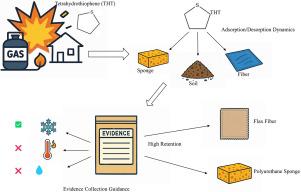Forensic analysis of tetrahydrothiophene (THT) at gas explosion scenes: Adsorption–desorption dynamics on common substrates
IF 2.2
3区 医学
Q2 CHEMISTRY, ANALYTICAL
引用次数: 0
Abstract
Tetrahydrothiophene (THT) is a common odorant in natural gas and plays a crucial role as key chemical evidence in post-explosion investigations. However, there has been limited research on the detection of THT in samples collected from gas explosion scenes. Headspace-solid phase microextraction-gas chromatography-mass spectrometry (HS-SPME-GC-MS) was employed to systematically investigate the adsorption and desorption behavior of THT on three common substrates: soil, sponge, and fabric. The results indicate that the physical and chemical properties of the substrate significantly influence the retention of THT. Polyurethane sponge and flax fiber exhibit the highest adsorption capacity, attributed to their larger specific surface area and porous structure. With soil as the representative substrate, humidity significantly reduces physical adsorption efficiency. Desorption kinetics exhibit significant temperature dependence: THT is released markedly faster as temperature rises, whereas storage under low-temperature conditions substantially prolongs its persistence on the substrate. The limit of detection (LOD) of the proposed method is 0.05 ng/g in soil, thus affording sufficient sensitivity for ultra-trace analysis. These findings provide a critical scientific basis for on-site evidence collection (prioritizing dry, porous materials), optimizing evidence preservation (immediate low-temperature storage), and enhancing the accuracy of forensic evidence interpretation in gas explosion cases.

瓦斯爆炸现场四氢噻吩(THT)的法医分析:在普通基质上的吸附-解吸动力学
四氢噻吩(THT)是天然气中常见的气味物质,在爆炸后调查中作为关键化学证据发挥着至关重要的作用。然而,从瓦斯爆炸现场采集的样本中检测THT的研究有限。采用顶空-固相微萃取-气相色谱-质谱联用(HS-SPME-GC-MS)系统研究了THT在土壤、海绵和织物三种常见基质上的吸附和解吸行为。结果表明,基质的物理和化学性质显著影响THT的保留。聚氨酯海绵和亚麻纤维具有较大的比表面积和多孔结构,具有较高的吸附能力。以土壤为代表的基质,湿度会显著降低物理吸附效率。解吸动力学表现出明显的温度依赖性:THT随着温度升高而释放明显更快,而低温条件下的储存大大延长了其在基质上的持久性。该方法在土壤中的检出限(LOD)为0.05 ng/g,具有足够的灵敏度。这些发现为瓦斯爆炸现场取证(优先选择干燥、多孔材料)、优化证据保存(即时低温保存)、提高法医证据解释的准确性提供了重要的科学依据。
本文章由计算机程序翻译,如有差异,请以英文原文为准。
求助全文
约1分钟内获得全文
求助全文
来源期刊

Forensic Chemistry
CHEMISTRY, ANALYTICAL-
CiteScore
5.70
自引率
14.80%
发文量
65
审稿时长
46 days
期刊介绍:
Forensic Chemistry publishes high quality manuscripts focusing on the theory, research and application of any chemical science to forensic analysis. The scope of the journal includes fundamental advancements that result in a better understanding of the evidentiary significance derived from the physical and chemical analysis of materials. The scope of Forensic Chemistry will also include the application and or development of any molecular and atomic spectrochemical technique, electrochemical techniques, sensors, surface characterization techniques, mass spectrometry, nuclear magnetic resonance, chemometrics and statistics, and separation sciences (e.g. chromatography) that provide insight into the forensic analysis of materials. Evidential topics of interest to the journal include, but are not limited to, fingerprint analysis, drug analysis, ignitable liquid residue analysis, explosives detection and analysis, the characterization and comparison of trace evidence (glass, fibers, paints and polymers, tapes, soils and other materials), ink and paper analysis, gunshot residue analysis, synthetic pathways for drugs, toxicology and the analysis and chemistry associated with the components of fingermarks. The journal is particularly interested in receiving manuscripts that report advances in the forensic interpretation of chemical evidence. Technology Readiness Level: When submitting an article to Forensic Chemistry, all authors will be asked to self-assign a Technology Readiness Level (TRL) to their article. The purpose of the TRL system is to help readers understand the level of maturity of an idea or method, to help track the evolution of readiness of a given technique or method, and to help filter published articles by the expected ease of implementation in an operation setting within a crime lab.
 求助内容:
求助内容: 应助结果提醒方式:
应助结果提醒方式:


